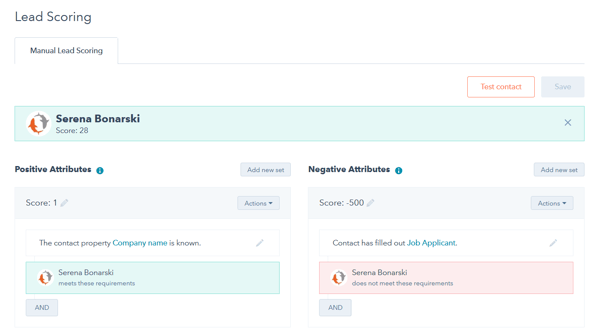6 Tips to Help You Get Started with Lead Scoring in HubSpot
Jillian Lambert

Scenario A: you’ve been working on your inbound marketing strategy and your efforts have paid off. You’ve been watching the leads roll in from several channels, but after you give yourself and your team a (well deserved) pat on the back, you have to figure out what to do with them.
Scenario B: you’ve been doing inbound for a while, but you hear from a coworker that Sales doesn’t think the leads you’re sending along are worth their time. Either of those sound familiar? You’re not alone. Defining what makes a lead qualified is a difficult task - but if you’re a HubSpot user, you’re in luck: leveraging the Lead Scoring tool makes it easier.
Would you rather listen to this content? Check out our video podcast below!
Lead scoring is a great method of sorting your leads between those just getting familiar with your brand, those who are candidates for nurturing, and those who are ready to talk to sales. Used in conjunction with Buyer’s Journey stages and your Buyer Personas, lead scoring can help you focus and personalize your marketing efforts, and the better qualified your leads are, the more efficient your sales team can be with their time.
1. Prioritize, Prioritize, Prioritize
When trying to determine whether a lead is qualified or not, the first step is to prioritize. After all, a contact who’s checked out your website once is probably less engaged with your company than someone who has opened, read, and clicked through on several emails - and that’s just the small stuff. One tried-and-true way to prioritize attributes that make a lead qualified is to look at historical data of current and past customers. What did they do before a salesperson reached out to them? What forms did they fill out, and which resources did they read?
It’s also important to consider the demographics of a well-qualified lead. If your company sells primarily to medical professionals, you might rank someone whose title is Dr. more highly than a Mr. or Ms. This is another great place to check back on the information of current or past customers, as well as using your Buyer Personas. Anything that’s relevant to whether or not this lead might buy can be used to score them: think industry, company name, size, and revenue, location, age, and more.
2. Break Out the Calculator
Getting started with lead scoring means you have to do a little math. If you’re anything like me, reading that might have elicited a frown, but don’t worry, we’ll walk you through it. Start out by calculating your customer-to-lead conversion rate. With a time scale that works for you (say, from when you started implementing inbound strategies, or in the last year) take your total new customers and divide it by total leads generated, then multiply the resulting number by 100 to get your percentage. Here’s how that looks:

Then, choose some attributes that make a contact a highly qualified lead. (Hint: they’re some of those priorities you identified.) Then calculate the close rate for that attribute with the same time scale and basic formula, customers over leads times 100. Now you’ve got a direct comparison. So, if your overall close rate is 10% and the close rate on a certain attribute is 30%, you’ll want to rate that attribute as about three times more valuable than a baseline attribute. To return to the earlier example, if visiting the website once is worth one point, clicking through a few emails might be three.
3. Do Your Research
So far I’ve been talking a lot about gathering stored data from past customers, but there are more resources that you can leverage to fine-tune your lead scoring. For instance, you might consider reaching out to customers and talking to them about what made them decide to purchase from your company - data doesn’t always give you the full picture.
Your sales department spends practically all of their time figuring out what drives people towards a sale, so ask them what resources they use to convince their prospects. If you have leads in your funnel who have accessed those resources, they’re probably more qualified than those who haven’t.
And finally, check out your attribution reports if you haven’t already. See where leads are coming from, and which sources are generating leads with high close rates. If people coming in from social are closing more frequently than those from organic, you’ll want to give more points to social engagement.
4. Embrace Negative Points
Lead scoring can help you easily distinguish which of your leads are worth pursuing, but it can also sort out which ones will probably never be a good fit. While it’s certainly more exciting to watch leads accumulate positive points, don’t be afraid to assign negative points to actions or demographic information that mean a lead is less likely to become a customer.
For example, if you have a page or form for people seeking job opportunities, they’re probably not that interested in purchasing your products or services. Or, say your company manufactures furniture for commercial use, and a contact indicated that they were looking to buy for their home. Chances are, that lead probably won’t be worth your salespeople’s time. In the search for the most qualified leads in your basket, be sure to define the bad as well as the good.
5. Use the Test Feature
At this point, you may be unsure if the point values you’re brainstorming are even going to work; thankfully, with HubSpot, there’s no need to guess. After setting up your positive and negative points, you can test the system with the handy “Test Contact” feature. Try using a variety of contacts, such as a current or past customer, someone who’s currently in the sales funnel, or even a brand new lead to see what numbers you generate. It should look something like this:

If you find that there’s not that much difference between a customer and someone who’s read a couple blogs, you should definitely reevaluate some point values. Everyone’s lead scoring system is going to be different, so as long as you can determine appropriate benchmarks for marketing qualified leads (MQLs), you should be golden.
6. Ready, Set, Automate
Of course, all that work doesn’t mean anything if you don’t use it, and while you can manually check contact lead scores, HubSpot isn’t called “marketing automation software” for nothing. You can integrate your lead scoring system into workflows to send a salesperson a notification when a contact has passed the MQL threshold, for example, or put someone into a nurture campaign once they’ve engaged a few times. Or, conversely, you can set up a workflow to remove a poor-fit lead from email lists and change their lifecycle status. The options are endless!
And for our last lead scoring tip: just like everything you do with inbound, always analyze, adjust, and repeat. What works now may change in the future, and as you gather more results from your efforts, you may find tweaks here and there. With a little planning and work, you can set up a lead scoring system that makes your company’s (and your partners') marketing/sales machine hum a lot smoother.
Ready to Dive In?
Work with our team of Business Process experts and watch us take manual clunky systems, tech stacks, and processes and turn them into tailored, intelligent workflows that deliver business outcomes.


